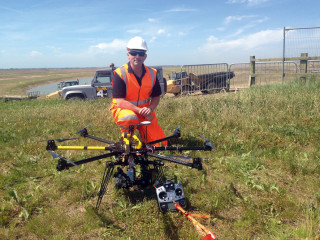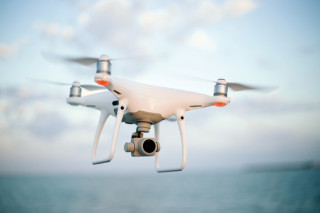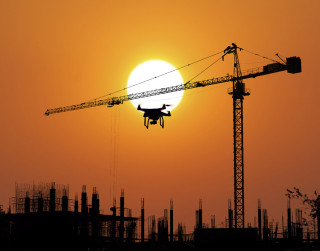Anybody watching the news – or camped-out in departures – over the Christmas break will have been impressed by how easily a simple remotely-controlled drone (un-piloted aerial vehicle, or UAV) can shut down one of the world’s busiest airports.
The closure of Gatwick airport over three days, from 19th to 21st December 2018, grounded 1,000 flights and affected over 140,000 passengers. A spokesman for Gatwick estimated that the cost to the airport and airlines in lost revenue was at least £20m.
Drone technology has developed at such a rapid pace in recent years that the regulatory framework controlling their use has failed to keep up with their proliferation, especially in commercial applications.
Professional-grade drones are expensive, complicated and highly versatile tools; they are often large and capable of travelling long distances at speed. The physical risks posed by a machine weighing several kilogrammes whizzing through the air at high speed are clear to see – and that’s before you start worrying about its potential to snoop into private spaces and personal affairs.
Relatively cheap hobby-type drones have already become a nuisance, as the Gatwick – and shortly afterwards, Heathrow – episodes demonstrate. They have long been a headache for the prison service due to the ease with which they can smuggle contraband into prisons.
“It is of little surprise that significant changes are afoot in respect of responsible drone use given that now two of the UK’s major airports have been disrupted in less than a month,” observes solicitor Karen Holden, founder and managing director of legal specialist A City Law Firm (ACLF).
“Long before the chaos at Gatwick and Heathrow, new regulations were already on the horizon concerning the use of drones,” she says.
The new regulations, which come into force on 30th November this year, will introduce new safety measures, including the requirement that all drones weighing over 250g are registered with the Civil Aviation Authority (CAA) and that all operators take an online safety test to prove that they understand UK safety, security and privacy laws.
The new rules will without a doubt create a new, much-needed framework but are unlikely to be the end of the matter. They will apply to both professional users and hobbyists, says Holden.
Following the events at Gatwick and Heathrow, it was announced that the police will also be given greater powers to deal with the misuse of drones including the right in certain circumstances to take over and land a drone and the right to seize drones and review any stored data.
The police will also have the power to demand that users produce valid documentation proving their right to operate the drone as well as evidence of its proper registration, just as they currently do with car drivers. The police will also be able to issue fixed penalty fines for some minor offences such as failing to land a drone if asked by a police officer or failing to show proper papers.
Efforts to regulate drone use continue to lag behind developments in drone technology and drone use, says Alan Perrin, chief instructor and assessor with the Commercial UAV Academy (CUAVA), a Cambridge-based training body for drone pilots.
He describes today’s UAVs as “a disruptive technology that is readily available [and] encourages people to use it immediately, without thinking of the consequences”.
Drones are widely used by amateurs and professionals alike and sales are booming. The CAA estimates that 1.5 million drones were bought in the run-up to Christmas 2017 and accountancy firm PWC predicts that the UK drone industry will be worth £42bn and employ almost 630,000 people by 2030.
Most of the growth in drone use will be driven by business, rather than consumers, says Perrin. “We’ve noticed a paradigm shift in terms of drone capability for deploying wherever and whenever needed,” he says. He adds that construction is one of the fastest-growing applications for drone technology.
“Beforehand we were training more hobbyists and sole operators who wanted to fly drones commercially. But there has been a shift away from owner-operators marketing drone services to business customers to businesses training their own people in-house,” explains Perrin.
In November 2018, the International Standards Organisation (ISO) published a draft voluntary code of practice for drone operations. “The idea is to introduce a level of standard that operators can use as a framework for their own in-house procedures,” says Perrin.
Since 2010, anybody using a UAV commercially needs to be properly trained and issued with a Permit for Commercial Operation (PfCO) by the CAA. Exactly what constitutes ‘commercial’ usage is somewhat vague: CAA defines it as “any flight by a small unmanned aircraft…in return for remuneration or other valuable consideration”.

This would include any drone usage as part of your job – in fact, any usage that isn’t purely for fun, says Perrin. Consequently, there are a lot of drones out there being used without the necessary training or permits. “Most of these people know they’re breaking the law,” says Perrin.
Although that might be true, the majority of law-breakers are at least not using their UAVs maliciously. However the security breaches at Gatwick and Heathrow in December demonstrated very graphically that anybody determined to use a drone for criminal purposes can do so easily with little risk of detection.
Along with its new drone laws, the government has now announced it is exploring ‘counter-drone’ technology. “Plans have been discussed to deal with geo-fencing which is a technology that works on GPS coordinates which can be built into a drone to stop it from entering certain zones,” says ACLF’s Karen Holden. “It is thought drone operators will be told to use apps to plan their flights to ensure they are not entering unsafe or no-fly zones, which will also be visible to other drone users.”
Nearly all modern drones have GPS receivers built into them and most drone software includes digital mapping capability. It is a simple matter to create a virtual exclusion zone around an airport, prison or other sensitive location and program the drone software to recognise this and alert the user to the exclusion zone – or even prevent the drone from entering.
But even if this is done, it is relatively easy to bypass such controls. In the wake of the Gatwick and Heathrow incidents there was much talk in the media about how rogue drones might be disabled by signal jamming, being shot down or blasted with lasers.
Alan Perrin is highly sceptical about the practicality of such measures. He quite rightly questions the wisdom of firing guns or high-powered lasers into the sky over Europe’s busiest airports; and he also doubts that signal jamming or radio interference could work. “The technical problems are enormous,” he says.
“Any virtual defence grid would have to be very, very complicated and the jamming technology would play havoc with all the other electronic infrastructure in the area,” Perrins points out. No airport would be able to operate under those conditions. Similarly, a massive electro-magnetic pulse directed at an errant drone would probably scramble all the radio signals for miles around.
As for more ‘intelligent’ measures to target drones individually – forget it, says Perrin. “Drone receivers typically use a unique 10-digit signal and use frequency-hopping to protect against attack,” he explains. Targeting a drone that’s switching frequency 500 times a second is simply not going to work.

The new regulations coming into force in November are in addition to existing laws governing drone use. It is already illegal to fly a drone higher than 400ft (122m) or within 500ft (152m) of built-up areas and drones must remain within direct sight of the user at all times.
Such restrictions are a frustration for construction industry users who might want to shoot aerial footage of a busy site, survey a city-centre building or take a look inside or behind a structure. But, as Perrin says, that’s the law and it must be obeyed. “Our clients are often disappointed to discover what they can’t do,” he says. “But once we’ve dashed everyone’s dreams we finish by showing them real drone footage [of a near-fatal drone collision] that demonstrates exactly why we need these laws.”
“The new rules which come into effect in November will without doubt create a new, much-needed framework but are unlikely to be the end of the matter,” says lawyer Karen Holden. “Clearly the government is taking the issue of responsible drone use seriously, not least due to the serious financial repercussions caused by incidents at Gatwick and Heathrow. So we are all watching this space as things will need to change.”
Who uses drones?
The use of data capture from drone technology continues to increase in the UK and Irish construction industries, with 52% of respondents now using the technology compared with only 33% in 2017, according to a recent survey by aerial mapping specialist ProDroneWorx.
The survey asked 150 senior figures within the construction, infrastructure and asset inspection markets about their perception, usage and understanding of the technology.
It found that the three main reasons for adopting the technology are improved data quality (56%), time saving (54%) and the reduction of risk (42%).
Drone technology is currently being under-utilised, according to ProDroneWorx. While 74% of respondents are using drone technology for photography and video, fewer than 30% of them are using it for value-added services like aerial light-detection and ranging (LiDAR), 3D point clouds, 3D modelling, digital surface/terrain models, orthophotos and thermal imaging.
The survey also found that:
• 52% of respondents are currently using drone technology in their operations
• 14% of drone users have been using this technology for more than three years
• 74% of non-users plan to adopt the technology in future
What the law says
Currently anyone operating a drone in the UK must:
• Keep their drone in sight
• Stay 150ft (46m) away from people and buildings if the drone is equipped with a camera
• Keep 500ft (152m) away from crowds and/or built-up areas if the drone is equipped with a camera
• Avoid flying over, or within 150ft (46m) of, open areas with more than 1,000 people present
• Adhere to all local authority rules about drone flights in the area
• Only fly the drones as and when it is safe to do so
• Understand your responsibilities under the General Data Protection Regulations (GDPR), especially if you are using a drone to monitor performance
• Have a proper risk assessment in place. It is also important to monitor employee compliance
• Have suitable insurance in place - All non-hobbyist drone operators must have Permission for Commercial Operations (PfCO) from the CAA.
Every commercial drone operator who has PfCO is issued with a document granting the permission and setting out conditions for its use. Third-party clients should ask the operator to produce his or her PfCO document and discuss how the work might be achieved within the conditions of the permission.
This article was first published in the February 2019 issue of The Construction Index magazine
UK readers can have their own copy of the magazine, in real paper, posted through their letterbox each month by taking out an annual subscription for just £50 a year. Click for details.
Got a story? Email news@theconstructionindex.co.uk




